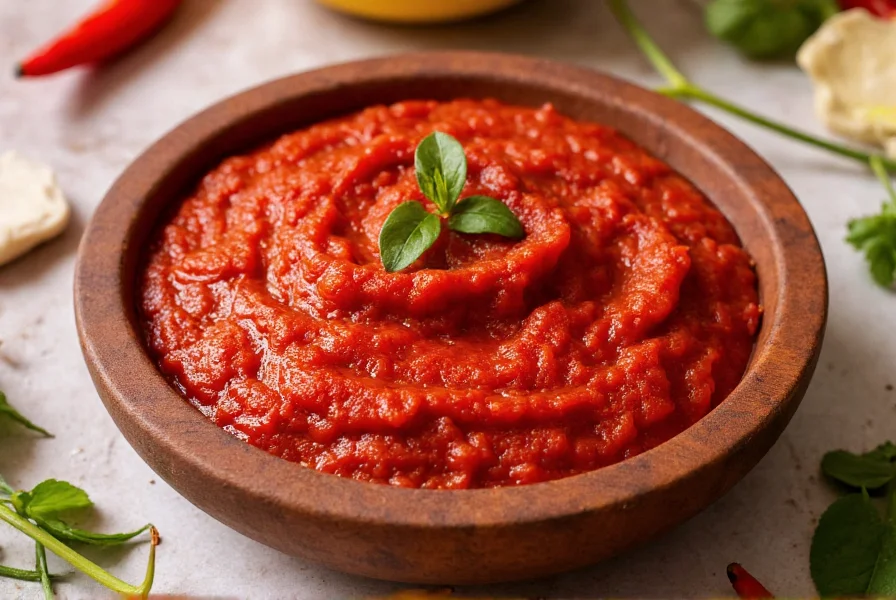Understanding this versatile ingredient begins with recognizing its fundamental difference from similar products. While roasted red peppers in jars contain significant liquid and are chunkier, the paste undergoes additional reduction that concentrates both flavor and color. This process creates a shelf-stable product that maintains the sweet, smoky essence of perfectly roasted peppers in a convenient form.
What Exactly Is Roasted Red Pepper Paste?
Roasted red pepper paste represents the concentrated essence of roasted bell peppers. Manufacturers typically start with ripe red bell peppers that undergo roasting—either over open flames or in ovens—until their skins blister and char. After cooling, the skins and seeds are removed, and the softened flesh gets pureed. The critical distinction from regular roasted peppers comes in the final reduction stage, where excess moisture evaporates until the mixture reaches a thick, spreadable paste consistency.
This concentrated form offers several advantages for home cooks and professional chefs alike. The paste delivers maximum pepper flavor without introducing unwanted liquid into recipes, making it ideal for sauces, marinades, and dishes where texture matters. Its rich crimson color enhances visual appeal while providing natural sweetness without added sugars.
Key Culinary Applications
Chefs value roasted red pepper paste for its ability to elevate numerous dishes with minimal effort. Consider these practical applications:
| Dish Category | Recommended Usage | Flavor Impact |
|---|---|---|
| Sauces & Dressings | 1-2 tablespoons per cup | Adds depth and natural sweetness |
| Marinades | 2-3 tablespoons per pound of protein | Creates caramelized crust when grilled |
| Stews & Braises | 1-2 tablespoons per serving | Enhances umami without acidity |
| Spreads & Dips | Base ingredient (25-50% of mixture) | Provides vibrant color and smooth texture |
Unlike liquid-based roasted pepper products, the paste integrates seamlessly into recipes without altering their fundamental texture. When incorporating into hot dishes, add the paste during the final 5-10 minutes of cooking to preserve its delicate flavor compounds.
Distinguishing From Similar Ingredients
Many home cooks confuse roasted red pepper paste with related products. Understanding these distinctions prevents recipe failures:
- Roasted red peppers in jars contain significant liquid and larger pepper pieces. To substitute, drain thoroughly and reduce in a skillet for 10-15 minutes until thickened.
- Harissa contains chilies and spices, delivering heat rather than pure pepper flavor. Use only when recipes specifically call for spicy elements.
- Sundried tomato paste offers similar texture but distinct flavor profile. While both provide umami, tomato paste lacks the sweet pepper notes.
- Pimientos come in jars with vinegar, creating a tangier, less concentrated product.
When selecting commercial roasted red pepper paste, check ingredient lists for additives. The purest versions contain only roasted red peppers and salt, while inferior products may include preservatives, oils, or thickeners that alter flavor and performance.
Proper Storage Techniques
Correct storage maintains both safety and quality of roasted red pepper paste. Commercial products typically remain shelf-stable until opened, but require refrigeration afterward. Follow these guidelines:
- Transfer opened paste to an airtight container
- Press plastic wrap directly onto the surface before sealing
- Refrigerate below 40°F (4°C)
- Use within 2-3 weeks for optimal flavor
For longer preservation, freeze the paste in ice cube trays, then transfer frozen cubes to freezer bags. Properly frozen, it maintains quality for 6-8 months. Thaw overnight in the refrigerator before use.
Effective Substitutions
When roasted red pepper paste isn't available, these alternatives work in various contexts:
- Homemade reduction: Simmer drained jarred roasted peppers until reduced by 75%
- Sun-dried pepper paste: Soak dried peppers in hot water, then blend to paste
- Paprika paste: Mix sweet paprika with minimal water (1:1 ratio)
- Roasted red pepper hummus: Blend with additional tahini to reduce chickpea flavor
Each substitute affects the final dish differently. The homemade reduction most closely matches flavor but requires preparation time. Paprika paste works best in spice-forward dishes but lacks fresh pepper notes.
Nutritional Profile
Two tablespoons (30g) of roasted red pepper paste typically provides:
- 25 calories
- 0g fat
- 6g carbohydrates
- 2g fiber
- 150% of daily vitamin C
- 10% of daily vitamin A
The roasting process enhances certain antioxidants while preserving most nutrients found in fresh peppers. Unlike many processed ingredients, this paste contains no added sugars or preservatives when purchased in its purest form.
Practical Usage Tips
Maximize your roasted red pepper paste with these professional techniques:
- Always taste before adding salt, as some commercial varieties contain added sodium
- For smoother sauces, blend the paste with a small amount of warm broth or oil
- Enhance color in tomato-based sauces by adding 1-2 teaspoons
- Create instant compound butter by mixing with softened butter (1:4 ratio)
- Revive stale bread by spreading thin layer and toasting briefly
Chefs particularly appreciate how this ingredient performs in emulsified sauces, where its natural pectin helps stabilize mixtures without requiring additional thickeners. The paste also freezes exceptionally well, making it practical to prepare in large batches during peak pepper season.

When making your own roasted red pepper paste at home, select fully ripe, deep red bell peppers for maximum sweetness and color intensity. Avoid peppers with green patches, as they indicate under-ripeness and will yield less flavorful results. The roasting process should develop deep char marks without burning the flesh, which would introduce bitter notes.












 浙公网安备
33010002000092号
浙公网安备
33010002000092号 浙B2-20120091-4
浙B2-20120091-4